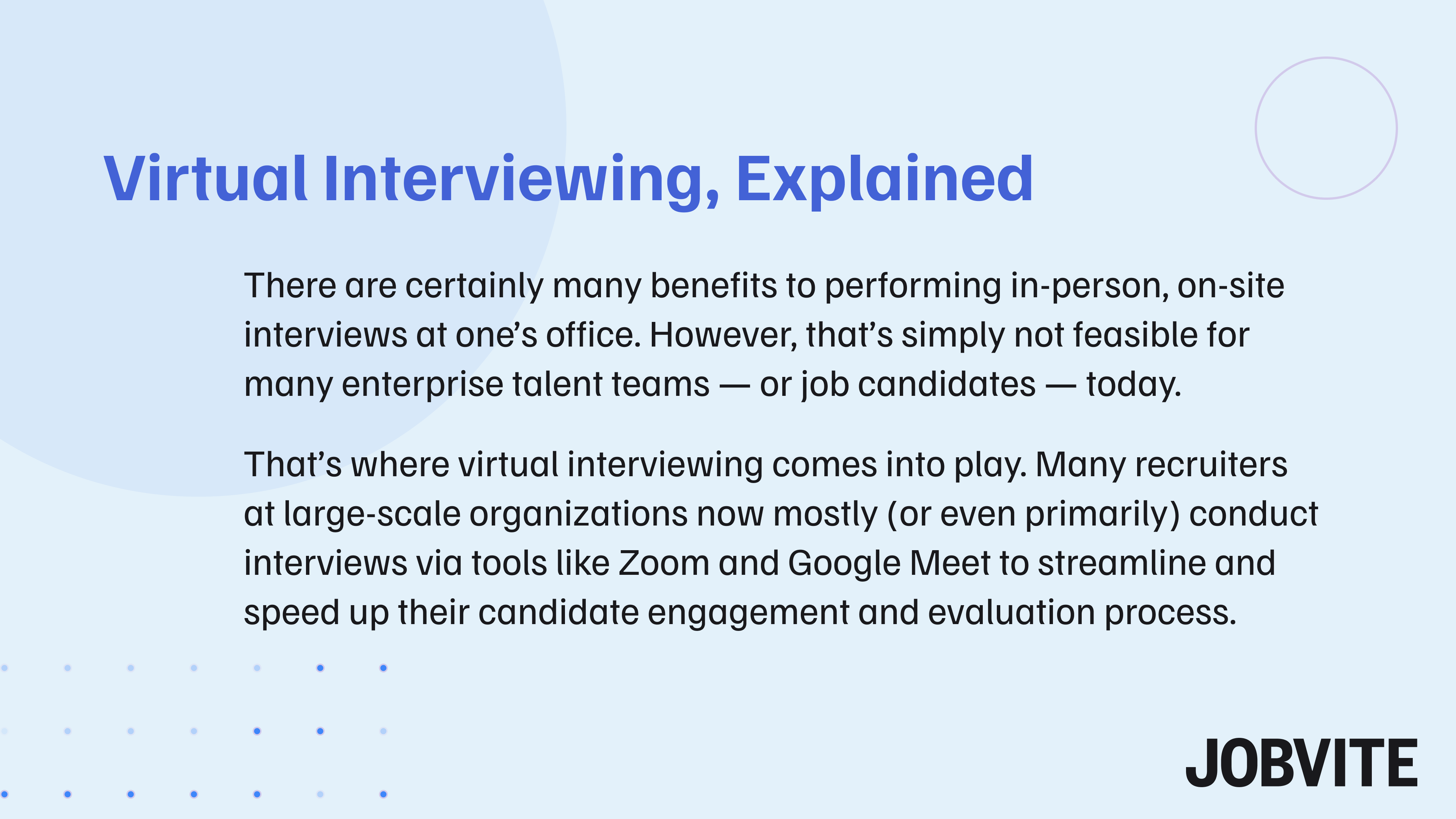What is a virtual interview?
The virtual interview has become the new standard for most of the job interviews conducted by recruiters today. Virtual interviewing, via video conferencing tools like Zoom and Google meet, is used in lieu of or in tandem with on-site/in-person interviews to discuss a position with a candidate.
These video calls offer flexibility for both talent acquisition specialists and job seekers alike.
- Recruiters can scale candidate engagement by speaking with numerous leads in a shorter amount of time without having to coordinate in-person visits.
- Candidates, meanwhile, can speak with more employers with job openings, since they don’t have to constantly travel from one office location to another.
What are the types of virtual interviews?
The virtual interview can be either live (i.e., a one-on-one chat between a hiring team and a candidate) or done asynchronously (i.e., one-way videos recorded and submitted by job seekers for hiring stakeholders to review at a later time).
Virtual interview
A live virtual interview is scheduled between a recruiter and candidate and conducted on a virtual meeting platform. These are usually done during a workday and may be followed by an in-person interview, for employers with offices.
Asynchronous interview
These interviews are timed, on-demand videos that a candidate records on their schedule and sends to a recruiter for review. These recordings are a great way to screen candidates for things like experience, certifications, and skills.
Virtual interview tips and best practices
Regardless of the video interviewing type, a virtual interview is still a great way to for candidates to impress recruiters and interview panelists — and vice versa. The below tips can help both parties make a good impression on one another:
- First thing’s first: Make sure your internet connection is stable to avoid any issues during the interview. Dropped or lagging calls can become frustrating to both job seekers and talent specialists, so make sure your WiFi or ethernet connection is strong beforehand.
- Keep background noise minimal, and conduct the interview in a room without distractions if possible. In today’s world, this has become increasingly difficult, given many professionals have young children, care for elderly relatives, and live in small spaces. That said, do your best to interview in an area that’s at least mostly quiet and private.
- Ideally, film in front of a “blank wall.” In area with a single-color wall behind you is ideal.
- Do your research on the role and company (candidates) and job seeker (recruiters) before the interview so you’re prepared to ask and answer questions.
- For candidates, specifically: Dress to impress. Even though it’s a virtual interview, hiring teams — which include the manager who will oversee the hired prospect — still wants to see a professional-looking candidate. Simply put, it shows job seekers are taking the interview process seriously.
- Ensure you have positive body language and make eye contact with the webcam. Ensuring your light source is strong/bright will help both parties see one another’s facial reactions, which can go a long way in communicating clearly and effectively.
- For recruiters: Keep the flow of the conversation moving along swiftly. Long gaps in between questions or making random small talk can be off-putting to some candidates, who may take that as a sign TA specialists they speak with are unprepared.
- Listen carefully. Sure, you can (and should, with the permission of prospects) record your video chats during screens and other interviews. That said, your candidates show genuine interest in your open roles. So, be an active listener who, while sticking to a structured interview script, so to speak, can ask relevant follow-up interview questions as needed.
What is the virtual interview process?
The virtual interview process is different for every role and org. But, there is a relatively similar approach implemented by large-scale brands today:
- The recruiter screens candidates via phone or asynchronous video.
- A live virtual interview is set up by the talent specialist for the prospect in question to speak with the hiring manager and potentially other panelists.
- Follow-up meetings are scheduled for additional live video or in-person interviews with those candidates the hiring team wants to continue with.
- An assessment is often provided for job seekers looking to take on more technical or advanced roles. A video call is then set up to go over results.
- Final-stage prospects are then spoken with one final time to address any lingering questions the hiring team has for them before they make a decision.
The more times you go through this process, the more you’ll refine your interviewing skills, which will only make you that much stronger in future interviews.

